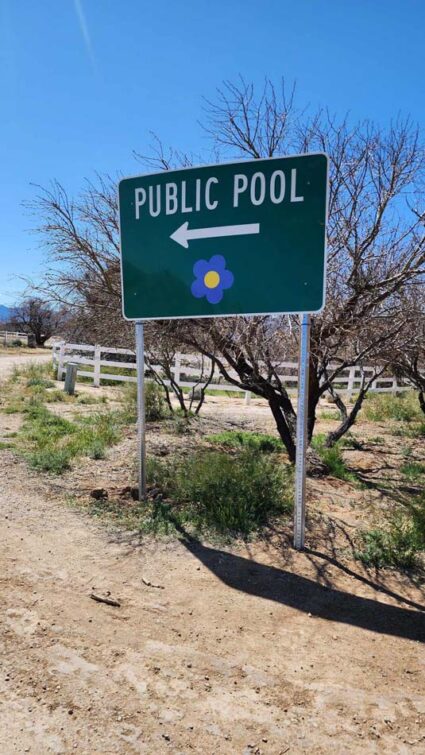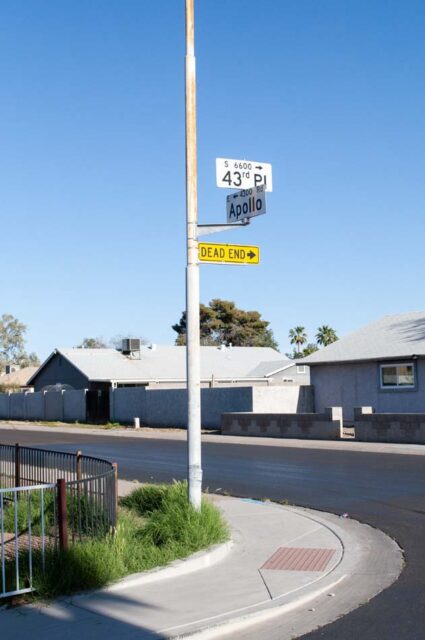The Neon Museum’s new executive director Aaron Berger discusses his career, Las Vegas’s diversity embedded in the museum’s collection, and his passion for glassblowing.
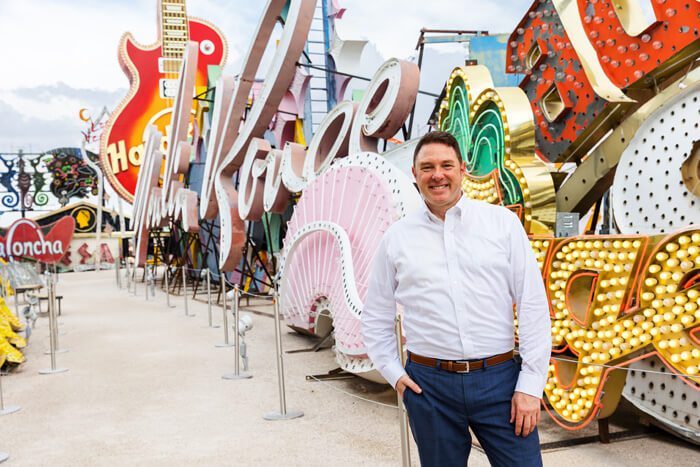
Each city is iconic, but not all have an abundance of elements that make it as unique as Las Vegas, Nevada. From the (ever-changing) Las Vegas Strip, to the development of atomic and mid-century modern motels, to the abundance of neon scattered across the city like jewels in an oversized necklace—these all make Las Vegas worth visiting.
When combined, you find the Neon Museum, one of the city’s top-rated attractions. Located north of the city’s Arts District on Las Vegas Boulevard (AKA the Strip), the museum’s visitor’s center is in the lobby of the former La Concha Motel. The historic, mid-century modern lobby leads visitors outside to a cacophony of color: the museum’s famed neon collection.
Aaron Berger joined the Neon Museum as their new executive director in July 2021, which is where our conversation began.
Hikmet Loe: Congratulations on your new position at the Neon Museum. Tell me about highlights in your career path.
Aaron Berger: The Neon Museum is my fourth museum as executive director and my second as a nationally accredited museum [Albany Museum of Art]. I’ve had an unusual career: interspersed in museums I have served as a consultant working in arts and culture. I directed a Jewish museum in Atlanta [the Breman Museum]; consulted; and now direct the Neon Museum.

HL: Congratulations on the museum’s recent accreditation by the American Alliance of Museums. How will that designation change collecting, programming, and conservation efforts?
AB: It changes everything: it’s an acknowledgement of best practices. Many board members and donors look to accreditation to assure the organization is operating as efficiently as possible, using donor dollars to the highest and best use, caring for the collection, and providing mission-driven education. What is unique is that the collection is different than a traditional museum. Take collections care: some signs date back ninety years; all were built to literally weather storms. We have them outside in brutal conditions: the Las Vegas sun, monsoons, and freezing winter temperatures.
HL: Explain your museum to someone who’s never been there.
AB: Our museum is the convergence of art and Las Vegas’s history. We tell this history through the medium of signage. A visitor may come for a selfie with the Hard Rock Cafe guitar, others may come to learn the stories of these iconic properties.
As a visitor, I was awed that we tell the stories of the Black experience. I moved to Las Vegas from the South where I was entrenched in the Civil Rights Movement: to learn about integration and segregation through signage was eye-opening. We tell the story of women, of the LGBTQ community, of Indigenous people. We tell the Jewish story and the Latinx story. When you come to visit, you get an understanding of those perspectives. The future, horizon view is that you’ll be able to take a deeper dive into each of those stories.

HL: Describe what place means to you and to your stewardship of the museum.
AB: The sense of place is critical because we have visitors from Indiana and from Ireland; from Nebraska and Nigeria. If you visit annually, you know the city changes, evolving in new and different ways. We have items that are six months old because the business came and went that quickly. No other place compares to Las Vegas in its brilliance, illumination, energy, attraction, enthusiasm, innovation. It culminates in the museum experience we have to offer.
For me, it’s about diversity. There are many definitions of diversity. We’re a place for families; for those who want an Instagram photo; for historians. We are a place where we tell many stories.
HL: Is there a neon work in Las Vegas you wish were on view at your museum?
AB: There are works we would love to have. The museum team is excited that many institutions take pride caring for these nostalgic pieces. There is an iconic image of a woman created decades ago by the Chamber of Commerce, “Vegas Vicky,” restored and now prominently displayed in one of the casinos. While I would love to have it at the museum, I’m thrilled to know that individuals, businesses, the gaming industry care for these works, keeping them alive outside the museum’s walls.
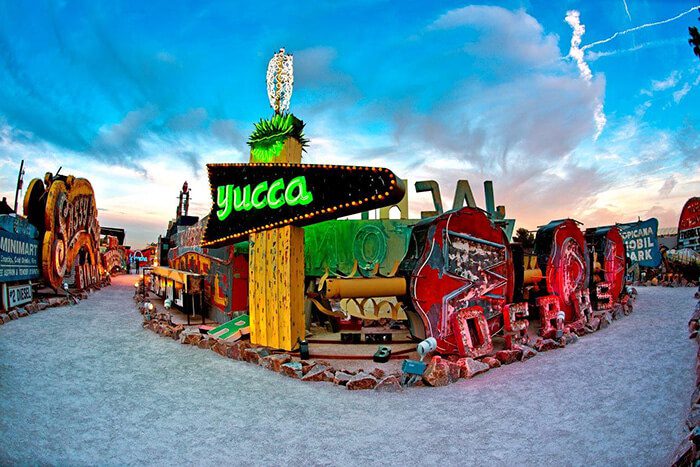
HL: Is there something at the museum that was a surprise to you?
AB: A constant surprise is collections care. In a traditional museum environment, red wine is the dangerous substance that can attack a work of art, but for a museum of signage it’s the cola drink that can be damaging and corrosive. It’s a sculpture garden: we’re dealing with animals climbing on our works and want to prevent them from doing damage. It’s a very thoughtful and much more challenging puzzle to put together.
There are twenty-four signs illuminated at night. However, we have about 250 signs in the Bone Yard. People ask us to light them all! There are two reasons we can’t: you would get a huge sunburn, and it would raise the surface temperature by forty degrees. When these signs were made, they used incandescent lightbulbs. We’re now using low energy lightbulbs, which still blink like they’re from the 1960s. We also have the use of solar energy.
HL: What past exhibition do you wish you would have seen?
AB: I would have loved to have seen the Tim Burton exhibition. I’m excited about the prospect of what we can show going forward. There are many opportunities and artists working in neon, artists like Glenn Ligon and Jung Lee are using neon in engaging and exciting ways; Dale Chihuly has used neon for over fifty years.
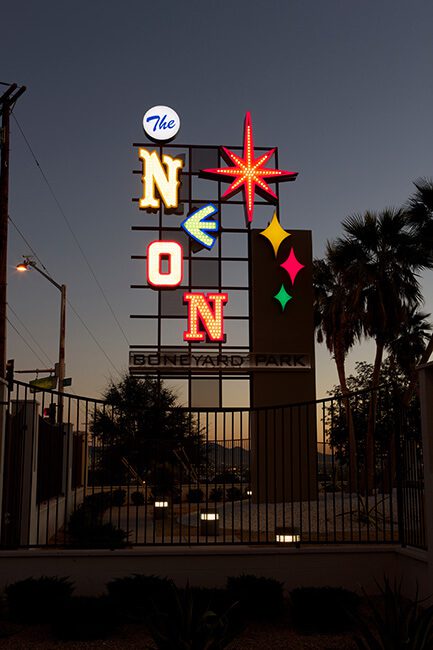
HL: If you weren’t a museum director, what would you be doing?
AB: My side hustle is that I’m a glass blower. I’m going to work with some of the sign makers at the museum. One dream is to have a fabrication shop on site so visitors can take a one-day class and leave with a memento. Or take a six-week class to learn how to bend neon and create art. I would pursue my love of glassblowing, but I think there’s a way to incorporate that into the museum’s future offerings.
HL: What surprises you about living in Las Vegas?
AB: Truthfully, it is the warmth of the people that I’ve met: the hospitality is something I thought was reserved for the Strip and it’s not, it’s engrained in the city’s residents. It’s really felt like home from day one.
Berger also offered these insights about two signs in the Neon Museum’s collection, The Moulin Rouge and Red Barn.
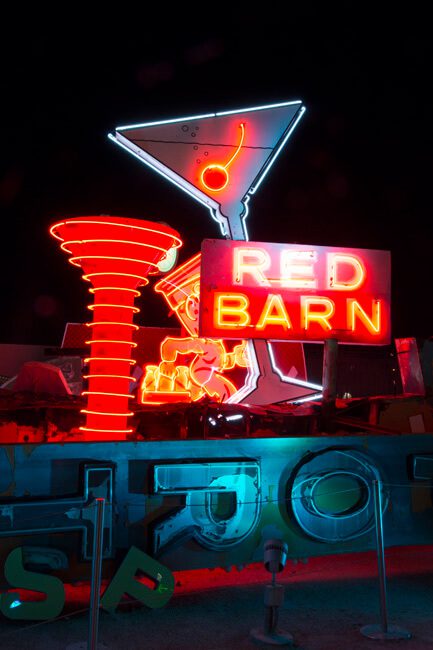
AB: The Moulin Rouge opened in 1955 and was the first integrated hotel-casino in the country. Great Black performers showcased their talents there including Lena Horne, Sammy Davis Jr., Count Basie, Dorothy Dandridge, and others. Black talent was allowed to perform on the Strip, but banned from gambling or staying on the Strip. The Moulin Rouge bridged that gap and provided a spot for talent to perform to integrated crowds at what was known as the “2:30 (am) show.”
By day, The Red Barn catered to straight customers but served a largely gay clientele at night. By the 1970s, it had evolved into one of the few openly gay bars in Las Vegas. Situated outside of the Strip, there was an understanding from “the Mob” that if the bar stayed away from the action in the city, the Mob would stay away from The Red Barn. It closed in 1988 and the building burned to the ground a few months later. The sign was saved by the Allied Arts Council, which founded the Neon Museum. This sign was one of the first on their list of rescues.
